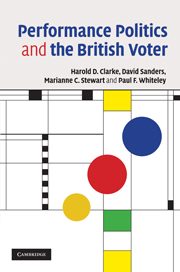Book contents
- Frontmatter
- Contents
- List of figures
- List of tables
- Acknowledgments
- 1 Performance politics and the British voter
- 2 The theory of valence politics
- 3 Valence politics and the long campaign
- 4 Tony's war
- 5 Electoral choices
- 6 The short campaign
- 7 Voting and political participation
- 8 Performance, people and the political system
- 9 Performance politics reconsidered
- Appendix A Vote in 2005 by socio-demographic characteristics
- Appendix B Turnout by socio-demographic characteristics
- Appendix C Dynamics of party identification
- Notes
- Bibliography
- Index
2 - The theory of valence politics
Published online by Cambridge University Press: 06 January 2010
- Frontmatter
- Contents
- List of figures
- List of tables
- Acknowledgments
- 1 Performance politics and the British voter
- 2 The theory of valence politics
- 3 Valence politics and the long campaign
- 4 Tony's war
- 5 Electoral choices
- 6 The short campaign
- 7 Voting and political participation
- 8 Performance, people and the political system
- 9 Performance politics reconsidered
- Appendix A Vote in 2005 by socio-demographic characteristics
- Appendix B Turnout by socio-demographic characteristics
- Appendix C Dynamics of party identification
- Notes
- Bibliography
- Index
Summary
In Political Choice in Britain (Clarke et al., 2004b) we examined several rival models of electoral participation and party choice. One model involved the role of social class given its historic prominence in academic accounts of electoral behaviour in Britain (e.g. Butler and Stokes, 1969; Heath et al., 1985; Pulzer, 1968). However, analyses revealed that social class now plays a relatively minor role in explaining party choice and, at least since the 1960s, the effects of class have been smaller than commonly assumed. The really powerful explanations of party choice are found in voter attitudes related to choice–based models of individual decision–making that see voters as active participants in a complex, dynamic and uncertain political process. These models contrast sharply with sociological accounts in which socio–economic forces and early socialization experiences drive people's political attitudes and behaviour.
Choice–based models of electoral behaviour are strongly informed by spatial and valence theories of political choice. The former theory has its origins in the work of Harold Hotelling (1929) and Duncan Black (1948, 1958), but was developed and popularized by Anthony Downs (1957). The latter theory derives from a seminal article by Donald Stokes (1963) which set out a comprehensive critique of spatial models. Spatial and valence models are closely related to each other, although this has not been fully recognized in the literature. This is partly because spatial models have received an enormous amount of attention from political scientists compared with valence models—their main theoretical rival.
Stated informally, spatial theory asserts that people vote for the party with which they most agree on the issues of the day.
- Type
- Chapter
- Information
- Performance Politics and the British Voter , pp. 30 - 52Publisher: Cambridge University PressPrint publication year: 2009



